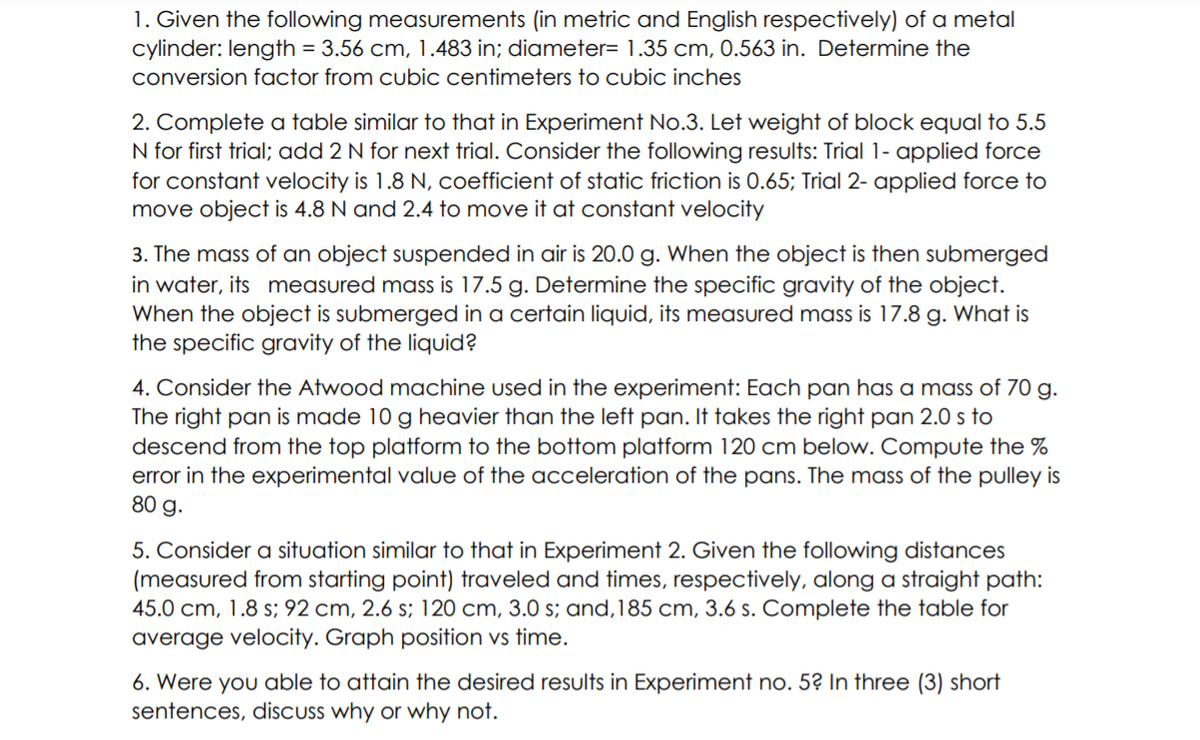1. Given the following measurements (in metric and English respectively) of a metal cylinder: length = 3.56 cm, 1.483 in; diameter= 1.35 cm, 0.563 in. Determine the conversion factor from cubic centimeters to cubic inches
1. Given the following measurements (in metric and English respectively) of a metal cylinder: length = 3.56 cm, 1.483 in; diameter= 1.35 cm, 0.563 in. Determine the conversion factor from cubic centimeters to cubic inches
College Physics
1st Edition
ISBN:9781938168000
Author:Paul Peter Urone, Roger Hinrichs
Publisher:Paul Peter Urone, Roger Hinrichs
Chapter11: Fluid Statics
Section: Chapter Questions
Problem 6CQ: Give an example in which density is used to identify the substance composing an object. Would...
Related questions
Question

Transcribed Image Text:1. Given the following measurements (in metric and English respectively) of a metal
cylinder: length = 3.56 cm, 1.483 in; diameter= 1.35 cm, 0.563 in. Determine the
conversion factor from cubic centimeters to cubic inches
2. Complete a table similar to that in Experiment No.3. Let weight of block equal to 5.5
N for first trial; add 2 N for next trial. Consider the following results: Trial 1- applied force
for constant velocity is 1.8 N, coefficient of static friction is 0.65; Trial 2- applied force to
move object is 4.8 N and 2.4 to move it at constant velocity
3. The mass of an object suspended in air is 20.0 g. When the object is then submerged
in water, its measured mass is 17.5 g. Determine the specific gravity of the object.
When the object is submerged in a certain liquid, its measured mass is 17.8 g. What is
the specific gravity of the liquid?
4. Consider the Atwood machine used in the experiment: Each pan has a mass of 70 g.
The right pan is made 10 g heavier than the left pan. It takes the right pan 2.0 s to
descend from the top platform to the bottom platform 120 cm below. Compute the %
error in the experimental value of the acceleration of the pans. The mass of the pulley is
80 g.
5. Consider a situation similar to that in Experiment 2. Given the following distances
(measured from starting point) traveled and times, respectively, along a straight path:
45.0 cm, 1.8 s; 92 cm, 2.6 s; 120 cm, 3.0 s; and,185 cm, 3.6 s. Complete the table for
average velocity. Graph position vs time.
6. Were you able to attain the desired results in Experiment no. 5? In three (3) short
sentences, discuss why or why not.
Expert Solution
This question has been solved!
Explore an expertly crafted, step-by-step solution for a thorough understanding of key concepts.
Step by step
Solved in 2 steps

Knowledge Booster
Learn more about
Need a deep-dive on the concept behind this application? Look no further. Learn more about this topic, physics and related others by exploring similar questions and additional content below.Recommended textbooks for you

College Physics
Physics
ISBN:
9781938168000
Author:
Paul Peter Urone, Roger Hinrichs
Publisher:
OpenStax College

Physics for Scientists and Engineers: Foundations…
Physics
ISBN:
9781133939146
Author:
Katz, Debora M.
Publisher:
Cengage Learning


College Physics
Physics
ISBN:
9781938168000
Author:
Paul Peter Urone, Roger Hinrichs
Publisher:
OpenStax College

Physics for Scientists and Engineers: Foundations…
Physics
ISBN:
9781133939146
Author:
Katz, Debora M.
Publisher:
Cengage Learning


Astronomy
Physics
ISBN:
9781938168284
Author:
Andrew Fraknoi; David Morrison; Sidney C. Wolff
Publisher:
OpenStax

College Physics
Physics
ISBN:
9781285737027
Author:
Raymond A. Serway, Chris Vuille
Publisher:
Cengage Learning

Principles of Physics: A Calculus-Based Text
Physics
ISBN:
9781133104261
Author:
Raymond A. Serway, John W. Jewett
Publisher:
Cengage Learning